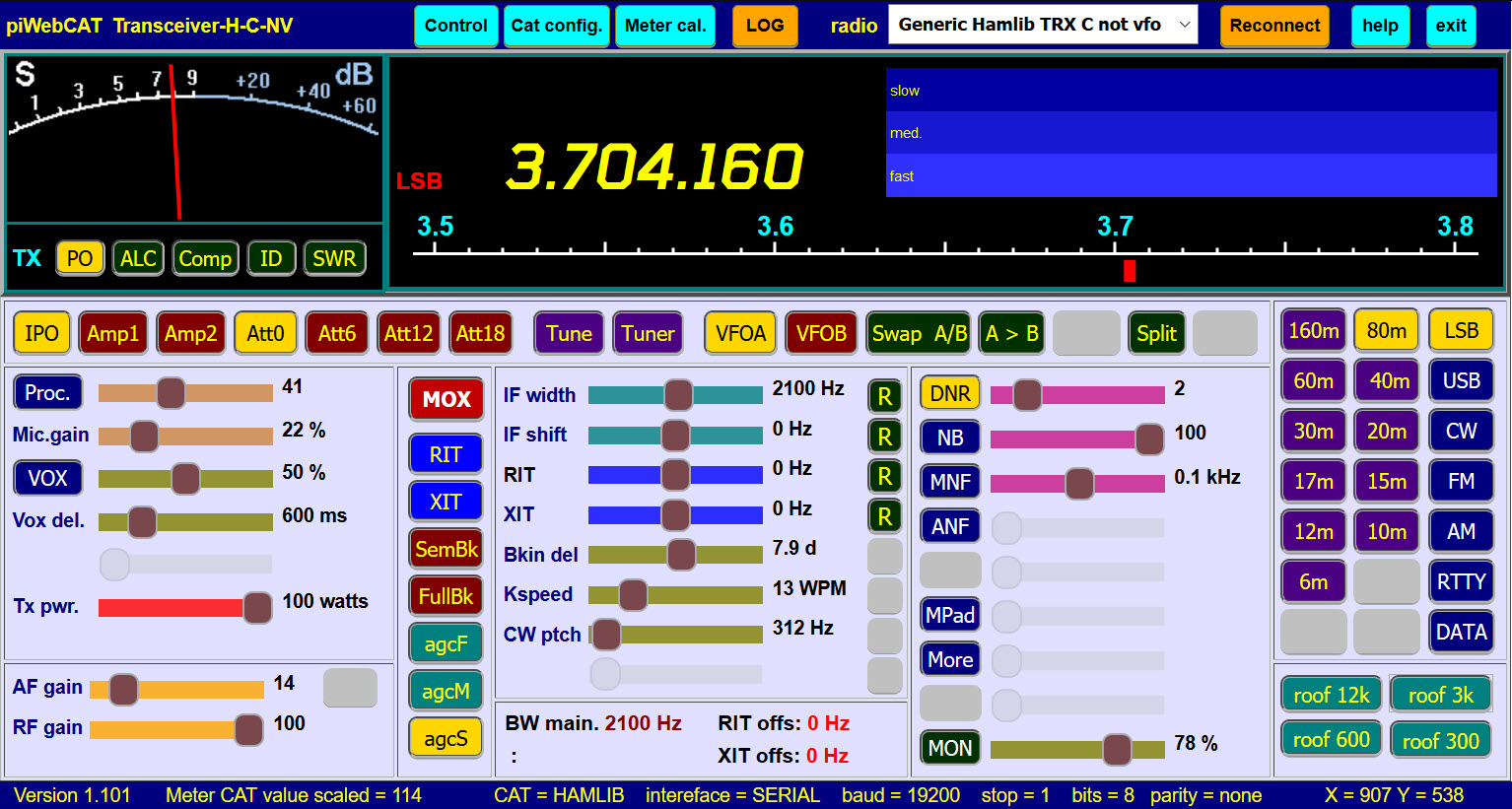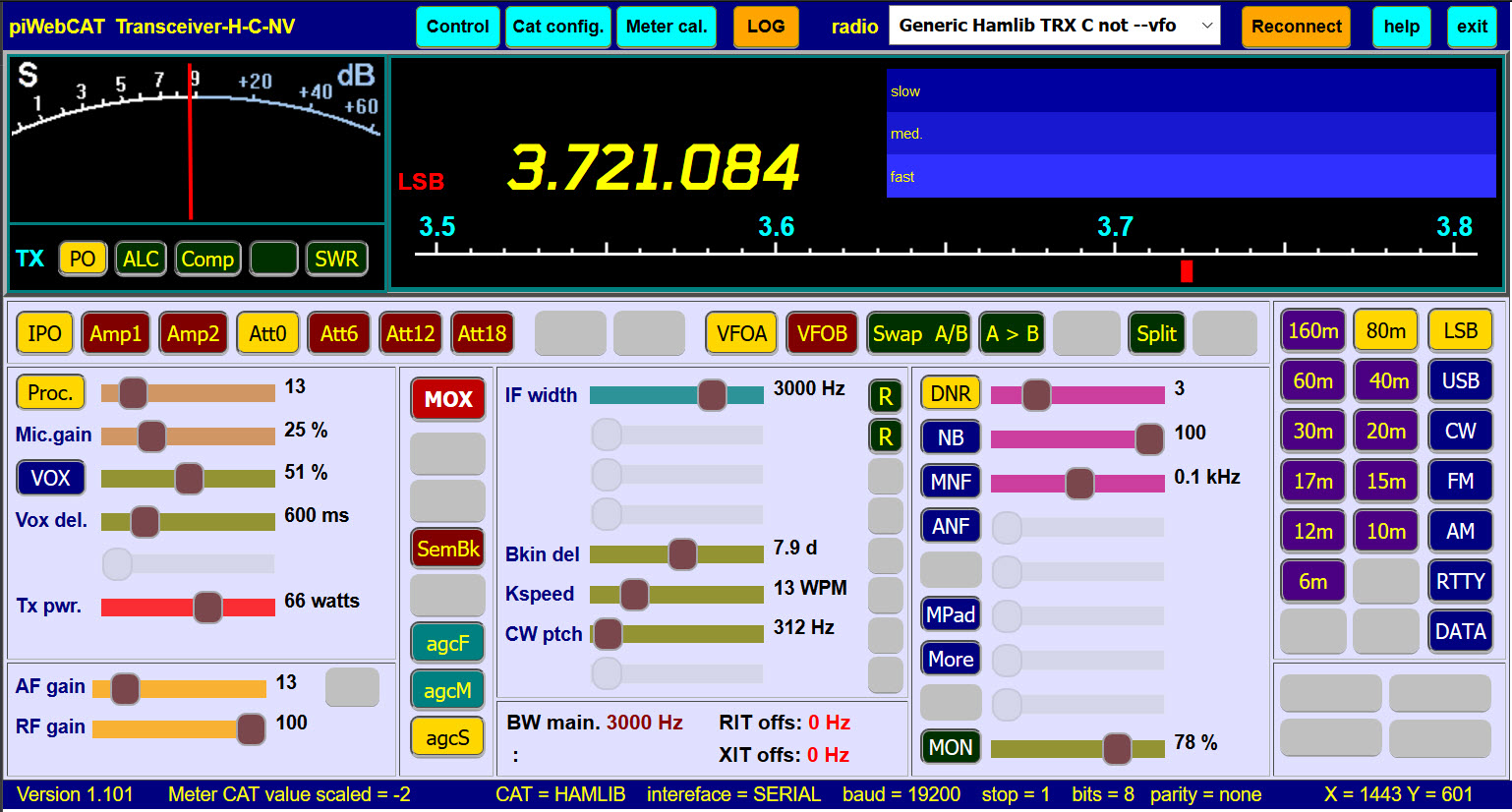2.15 Learning guide Transceiver-H-C-NV non ---vfo mode
Select Transceiver-H-C - the piWebCAT window is shown below.
26 new buttons and 14 new sliders have been added to the previously studied Transceiver-H-B layout.
Some buttons have been move. This done very easily by changing the buttons numbers.
( A button and slider numbering layout is shown in section 3.6 Button and Slider numbering ).
All of these controls use Hamlib rigctl
Some controls are ineffective in my IC7000, eg: Roofer buttons, RIT, XIT, Tune, Tuner, IF Shift.
These have been disabled in the configuration on the SD card and therefore do not appear. See next page.
They are easily reinstated by changing their active field from N to Y or S in the buttonshl or slidershl table.
I suggest enabling new controls with active=Y. They will then only be read once.
If you enable with active=S (sync), then piWebCAT attempts to read the parameter from the rig every few
seconds and you have succession of error messages. Switch to active=S when your a happy that they are ok.
They are all read at startup. If any one is not supported there will a brief delay and '? disconnection' error box.
It can be tricky to identify which item is doing this (either through not being supported or a mis-spelt command)
It is therefore advisable to only re-enable one control at a time.

- Proc, Mic-gain, VOX and VOX delay sliders added. Two have adjacent buttons which double as labels.
These four are commonly used controls and I would expect that most users would keep these positions. - The middle panel sliders have adjacent R buttons = reset to default.
The right panel sliders have adjacent on/off buttons which double as labels. (Set slider captions to 'nocap')
IF shift is in the middle panel because it needs reset to zero.
I have positioned RIT and XIT in the middle panel because reset to default (zero Hz) is essential.
But RIT and XIT on/off buttons are also needed. They are almost adjacent in the narrow 8-button panel !!! - Roofer buttons are bottom right. These are not dedicated buttons - they could be used for something else.
Roofer buttons could be elsewhere if you wished. (Not used in IC7000) - Note the three CW sliders are in the middle panel. I positioned them here near the break-in buttons.
They could easily be move elsewhere by changing their sliderno fields in table slidershl.
The MORE and MPad popup buttons were moved by changing the btnno field in the buttonshl table. - Note the four text items middle bottom. These are configured in the slidershl table.
They are discussed in detail in section 2.4 Text display box. - Note that there is no VFO B > A copying button. This function is not supported by Hamlib.
I could, for the IC7000 implement it by using \send_cmd_rx BA; 0 (a direct rig command). - I have added three AGC buttons: fast, medium and slow. Examination of the buttonshl table
reveals data values (nset and nans): fast=2. medium=5 and slow=3.
The values in the IC7000 CAT manual are 1, 2 and 3. So where do we find 2, 5 and 3 ?
See section 2.17 Learning: Hamlib data? also section 8.5 rigctl - at the command line
Examine the configuration of the Breakin delay, Keyer speed and CW pitch sliders in table slidershl.
My intention is usually to display in the same units as on the rig.
Eg; Bkin delay: the values on the rig are 2.0d to `12.8d. The data received from rigctld data is 1 to 255.
The data range must be made to correspond to the full range of the slider. The text presentation
to the right of the slider must be 2.0d to `12.8d. piWebCAT's formatting fields in table slidershl provide the
means to achieve this. The process will then operate in both directions, ie: slider controlling the rig parameter
and slider following the parameter's value on the rig (if active=S = sync is set).
The same configuration but with Roofer, RIT, XIT, Tune, Tuner and IF Shift inactivated for IC7000 operation.
